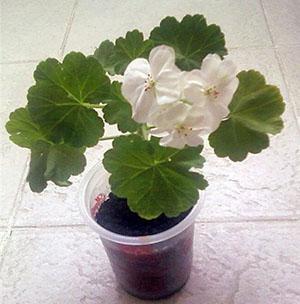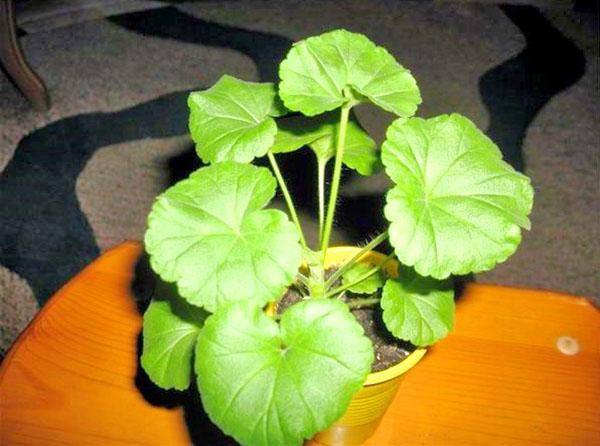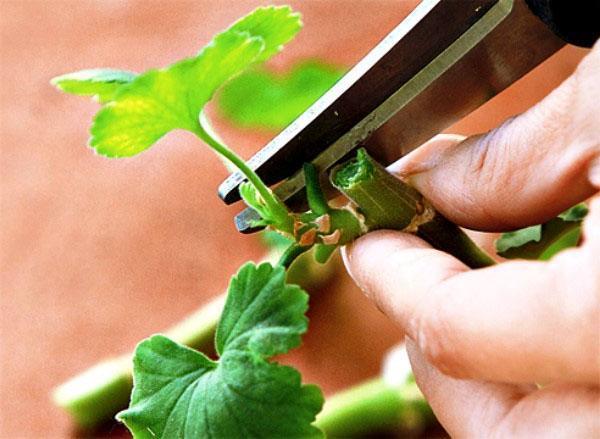Amateur breeding of geraniums indoors
 Young geranium bushes look more attractive, bloom better and take up little space on the window. Reproduction will rejuvenate old geraniums, leaving several buds on old stems. Young cuttings, obtained in early spring, will thank them with abundant flowering in the summer in a group planting or in separate cups.
Young geranium bushes look more attractive, bloom better and take up little space on the window. Reproduction will rejuvenate old geraniums, leaving several buds on old stems. Young cuttings, obtained in early spring, will thank them with abundant flowering in the summer in a group planting or in separate cups.
Ways to propagate geraniums at home

Available to the amateur:
- cuttings of tops and stem middle parts of the plant;
- division of roots;
- seed method of reproduction.
Most often, they use the method of cuttings, when more than a dozen new plants can be obtained from one adult plant. The resulting cuttings are germinated in various ways. Geranium, when propagated by cuttings, quickly enters into flowering, retains the properties of a mother plant.
 Root division is carried out when a healthy bush becomes cramped in a pot. When transplanting, it is cut so that living ground kidneys remain on all divisions. Such reproduction, weakened by hunger and diseases, the bush will not withstand.
Root division is carried out when a healthy bush becomes cramped in a pot. When transplanting, it is cut so that living ground kidneys remain on all divisions. Such reproduction, weakened by hunger and diseases, the bush will not withstand.
Geranium from seeds is bred at home if there are no prepared cuttings or to obtain a plant of a new variety. Getting seedlings from seeds is not difficult. But at the time of flowering, young bushes enter much later.
How to propagate geranium by cuttings at home
 Before the mother plant gives birth to new offspring, it must be prepared. Some hobbyists recommend propagating the plant in the fall after flowering has stopped. However, the majority believe that young plants develop most successfully during February cuttings from a mother bush prepared in winter.
Before the mother plant gives birth to new offspring, it must be prepared. Some hobbyists recommend propagating the plant in the fall after flowering has stopped. However, the majority believe that young plants develop most successfully during February cuttings from a mother bush prepared in winter.
Geranium propagation is carried out by cutting off cuttings with a sharp, clean knife under a leaf. In this case, the tip should have 2-3 or more healthy leaves after exposing the petiole. If the stem allows, then cuttings can be cut from the lower bare trunks, but there should be dormant buds from where a new plant will begin to grow.
 How does geranium multiply, if it is stubborn, the cuttings do not take root? There is a radical way with a full guarantee of survival. On the bare trunk, circular cuts must be made throughout the stem two weeks before the branch separates from the mother plant. The incisions are made through the kidney. In places of injuries, gum floats, in it the rudiments of roots are tubercles. Delenki take root, grow quickly.
How does geranium multiply, if it is stubborn, the cuttings do not take root? There is a radical way with a full guarantee of survival. On the bare trunk, circular cuts must be made throughout the stem two weeks before the branch separates from the mother plant. The incisions are made through the kidney. In places of injuries, gum floats, in it the rudiments of roots are tubercles. Delenki take root, grow quickly.
 The cuttings need to be dried for several hours, then the sections should be treated with activated carbon or Kornevin. This stimulation promotes the rapid formation of horse rudiments.
The cuttings need to be dried for several hours, then the sections should be treated with activated carbon or Kornevin. This stimulation promotes the rapid formation of horse rudiments.
In the spring, geranium breeding can be carried out at different times. If the plant takes root in March, there will be a full flowering bush in the summer. Late propagation of geraniums by cuttings in the spring will postpone flowering until the next season.
For rooting to be successful, it is necessary to germinate the cutting in a special environment. Requirements for the substrate are sterility and air permeability.The composition of the soil includes a universal soil with the addition of a third of vermiculite and sand. The earth is spilled with boiling water or hot potassium permanganate. Expanded clay or pieces of polystyrene are placed in the container on a perforated bottom, and soil is poured on top.
The cuttings are deepened into the ground by 2 cm, kept in the dark for 3-4 days, then put on a cool window with shade from the sun. Watering moderately, through the pallet, so as not to wet the cuttings. The plant is covered with a jar only if the leaf turns yellow and the stalk withers. The tugor will recover in a few days. The main danger at this time is excessive soil moisture.
 It is much easier to expel the roots when propagating geraniums by cuttings in water. The whole process takes place before our eyes. The pre-dried cutting with the bottom leaves removed is placed in a jar of water and activated carbon. The roots will appear within two weeks. When they grow, rooting is carried out in the usual soil composition to a permanent place.
It is much easier to expel the roots when propagating geraniums by cuttings in water. The whole process takes place before our eyes. The pre-dried cutting with the bottom leaves removed is placed in a jar of water and activated carbon. The roots will appear within two weeks. When they grow, rooting is carried out in the usual soil composition to a permanent place.
What you need to consider when grafting geraniums at home:
- All operations for the separation of cuttings and their preparation are carried out under sterile conditions. The knife, scissors and all utensils must be clean.
- You need to water the new plants with warm water, so that the water does not get on the plant.
- Only dead plants need to be covered.
- Rooting is carried out at a temperature of 15 degrees.
- Geranium breeding takes all year round, but the process is most efficient in spring.
- Planting young plants in groups at a distance of 15-17 cm for fast flowering.
 New plants take root in different ways, depending on the variety. Zonal and ivy varieties take root quickly. A month is required for the survival of royal varieties, fragrant, will show the first leaves in a month and a half. Bloom royal geraniums only the next year, like the angelic ones.
New plants take root in different ways, depending on the variety. Zonal and ivy varieties take root quickly. A month is required for the survival of royal varieties, fragrant, will show the first leaves in a month and a half. Bloom royal geraniums only the next year, like the angelic ones.
How to propagate geranium from seeds at home
 Seed propagation of geraniums is less common. If you collect seeds from your plants, you can get a bush that will be different from the parents. More often new varieties are obtained from seeds during breeding. But it is not difficult to grow geraniums from seeds at home, only it will take more time to develop a full-fledged bush.
Seed propagation of geraniums is less common. If you collect seeds from your plants, you can get a bush that will be different from the parents. More often new varieties are obtained from seeds during breeding. But it is not difficult to grow geraniums from seeds at home, only it will take more time to develop a full-fledged bush.
Seeds will sprout faster if scarified. The purchased seeds may have been processed. Own, you need to wipe it with sandpaper, destroying the upper dense layer of the shell. After that, the seeds are soaked in a stimulant for three hours.
For the seed method, for greater efficiency, it is necessary to take into account:
- optimal time for sowing seeds;
- dependence of soil temperature and germination time;
- seedling substrate;
- picking and caring for plants.
 The soil for sowing should be light and sifted, as the seeds are small. The substrate is made up of turf, peat and sand in a ratio of 2: 1: 1 parts. It is imperative to disinfect the substrate by any available means. The composition is moderately moisturized, leveled. The seeds are laid out at a distance of 5 cm, and sprinkled with sand 0.5 cm thick.
The soil for sowing should be light and sifted, as the seeds are small. The substrate is made up of turf, peat and sand in a ratio of 2: 1: 1 parts. It is imperative to disinfect the substrate by any available means. The composition is moderately moisturized, leveled. The seeds are laid out at a distance of 5 cm, and sprinkled with sand 0.5 cm thick.
After sowing, the container is covered and placed in a warm, dark place. As soon as the seeds hatch, place the pot in a bright place in a cool place. While the seeds are sprouting, the glass is removed, water drops are removed from it, the soil is ventilated.
The optimum temperature for seed germination is 20-22 degrees. The cotyledons, if the temperature is not lowered, will stretch out and may fall. At this time, the appearance of a black leg should not be allowed. Sprinkle with pinkish water with potassium permanganate, without wetting the seedlings. It is important to moisturize the substrate in moderation, avoiding stagnation of water in the ground.
 Two weeks after germination, the plants dive, after 45 days the plants are planted in a permanent place. Since geraniums multiply from seeds for a long time, they need to be sown starting in December. True, the earlier the seedlings sprout, the more care will be required, backlight. But seedlings from seeds will bloom early.
Two weeks after germination, the plants dive, after 45 days the plants are planted in a permanent place. Since geraniums multiply from seeds for a long time, they need to be sown starting in December. True, the earlier the seedlings sprout, the more care will be required, backlight. But seedlings from seeds will bloom early.
You shouldn't delay picking plants either. The root system, growing, will intertwine, and the pick will take place with a delay in development.
Seedlings can be cut into separate cups with a diameter of 10 cm or into a common container for flowers at a distance of 15-17 cm.
 When the sixth leaf appears on the plants, the bushes need to be pinched. to form, so that geranium from seeds at home pleases with abundant flowering of cranes. However, it must be remembered that fragrant geranium has its own development cycle; at home, the plant behaves differently. Longer development goes on in capricious royal geraniums.
When the sixth leaf appears on the plants, the bushes need to be pinched. to form, so that geranium from seeds at home pleases with abundant flowering of cranes. However, it must be remembered that fragrant geranium has its own development cycle; at home, the plant behaves differently. Longer development goes on in capricious royal geraniums.
Root propagation of pelargonium from sprouts
If pelargonium sprouts from the root, new bushes can be obtained from them. To do this, the bush is removed from the ground, shaken off and the root system is divided so that the young rudiments of the leaves have roots for nutrition. It is important that the bores are small, otherwise the roots will intertwine and it will be impossible to separate them. The soil should be of normal composition, the bowl is small, no more than 10 cm in diameter.
That's all the wisdom of breeding pelargonium. In the course of work, each gardener develops his own techniques, at times, far from the recommended ones.